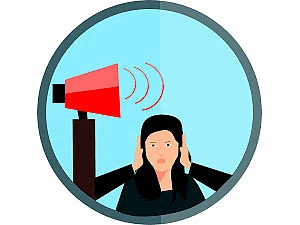'Noise pollution is a silent killer, let us make conscious efforts to stop noise pollution' – this message popped up on Wednesday on the website of the Department of Environment (DoE). The message was displayed as the DoE observed International Noise Awareness Day on Wednesday.
But the reality is that the noise pollution in the capital is becoming rampant day by day. This silent killer has become unstoppable. There is no effective initiative to control noise pollution. Earlier, noise pollution levels were higher than the tolerable level for an average of 12 hours in the capital. Now it has extended to 14 hours. A study by the Center for Atmospheric Pollution Studies (CAPS), Department of Environmental Sciences, Stamford University revealed this information.
CAPS measured the noise level of a total of 82 intersections of two city corporation roads in Dhaka last January. The study used an automatic sound level meter made in Taiwan. CAPS chairman professor Ahmad Kamruzzaman Mazumder led the study.
Study findings
According to the Noise Pollution (Control) Rules 2006, the standard level (maximum limit) of noise during the day for Dhaka is 60 decibels. Research shows that the noise intensity in two city corporations of Dhaka is almost double that the tolerable level.
The average noise level in Dhaka South City Corporation area was found to be 76.80 decibels. The three road junctions with the highest level of noise pollution are New Market intersection, Naya Paltan intersection and Press Club intersection. The level of noise pollution in those spots is 100.65 decibels, 92.22 decibels and 90.03 decibels respectively. South City had the lowest noise pollution at the Zero Point intersection, at 77.60 decibels.
The average level of noise in Dhaka North City Corporation was found to be 80.56 decibels. The three road junctions with the highest level of noise pollution are Mohammadpur bus stand junction, Shia Masjid junction and Mascot Plaza junction. The level of noise pollution at these places is 99.77 decibels, 93.05 decibels and 90.27 decibels respectively. In North City, the least pollution was found at Mirpur Beribandh intersection at 74.86 decibels.
Sources of air pollution in Dhaka include vehicular noise (horn, engine, wheel friction and vibration noise), construction noise, factory noise, generator noise, noise of loudspeaker at social events and so on.
Earlier in 2017, CAPS conducted a study on noise pollution. The latest one was carried out in January. Caps chairman Ahmad Kamruzzaman Majumder told Prothom Alo on Wednesday that the pollution has multiplied more than before presenting a comparative analysis of the two studies. Most alarmingly, Dhaka's noise pollution has increased over time. Referring to this, Kamruzzaman Majumder said, noise pollution higher than the tolerable level in Dhaka spanned for 12 hours a day in 2017 which has shot up to more than 14 hours.
He said that the population has increased in the city. The number of vehicles has also increased. There is mobility at night as well for which the duration of noise pollution is increasing.
Effects of noise pollution
Bangabandhu Sheikh Mujib Medical University assistant professor (Ear Nose and Throat), Hasanul Haque, commented that health problems are becoming evident due to noise pollution in the capital. He said, noise pollution causes hearing loss, deafness, irritability, lack of sleep, heart disease, disruption of studies and so on.
Children’s cognitive development is obstructed due to noise pollution. Citing his own experience, he told Prothom Alo that more than 40 per cent of his patients come with hearing problems 30 per cent of who suffer from hearing loss.
Government action
The Department of Environment is working with the government departments to control noise pollution. It is running a project, 'Integrated and Partnership Project on Noise Pollution Control'. Under this project, a study has already been done on the noise pollution situation in Dhaka city, said Syeda Masuma Khanam, director (Natural Resource Management) of the Department of Environment.
She said, “A state of noise pollution has been determined in the research of the Department of Environment. We have undertaken several programmes to curb noise pollution. The prime initiative will be to amend the Noise Pollution (Control) Rules, 2006. BRTA and the traffic police will be involved in our work as part of an integrated initiative.”
*This report, originally published in Prothom Alo print edition, has been rewritten in English by Farjana Liakat
